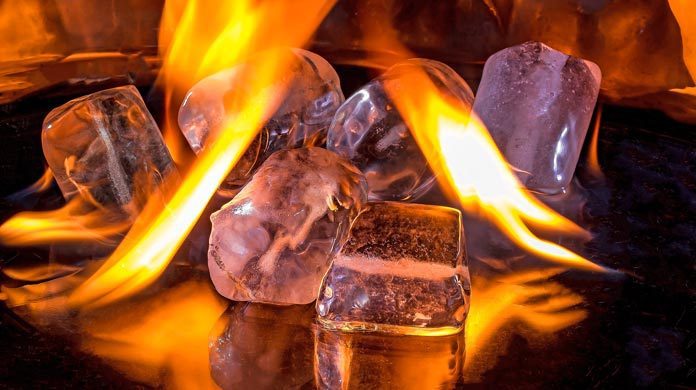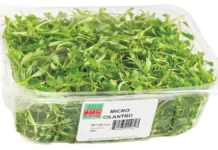
Ice machines perform best when they operate in optimal conditions, which generally means 70 degree air and 50 degree water temperatures. Unfortunately this is not typically the environment found in a commercial kitchen.
Higher temperatures in a room will force an ice machine to work harder to produce ice – in fact, a room that is too hot can be the cause of your ice maker not making ice. For this reason, it is important to consider the placement of the ice machine based on the ideal environment, rather than just where is most convenient, or where it will fit best.
As a general rule, a hot room is a bad place for an ice machine. Ideally you want the room temperature to be in the 70s, however many commercial kitchens run quite a bit warmer than this on a regular basis. In this article we will look at what happens when an ice machine is located in a room that’s 100 degrees.
For starters, when the room heats up to 100 degrees or more, you may find your ice maker not dispensing ice, and the ice you do have will melt faster. What could be worse than your ice maker not making ice? You could damage your machine and experience a full system shutdown!
When we discuss temperatures of 100 degrees or more, many people find it difficult to believe that air temperatures climb that high in their establishment when they don’t notice it. That is because an ice machine can have its own microclimate. Easy Ice studies have shown that the air recirculating though the ice machine can be up to 25 degrees hotter than the ambient room temperature when measured at a point less than 5 feet away from the ice machine!
Table of Contents
Ventilation around the Ice Machine
A Hoshizaki air-cooled ice machine uses a fan to suck air in the front of the ice maker and across the condenser to cool (i.e. remove the heat) from the water in order to produce ice. It vents the hot air through the rear of the ice maker, which is usually 6-8 inches away from the wall. When the warm air slams in to the wall, it will try to move in all directions. However, if the air is restricted by the ceiling, side walls or other equipment, it will mostly drift in the direction of a fan that is sucking air in. Of course, the closest fan sucking in air is the ice maker. This “hot air recirculation” is what causes the ice machine microclimate. We have seen kitchens that are 85 degrees whose ice machines is recirculating degree air…which forces the machine to work longer and harder to expel the heat in order to create the ice…which causes the unit to generate still more heat. It is a vicious circle that can result in ice maker not making ice.
One of the most effective ways to reduce this temperature is by making sure that your ice machine is placed in a space with enough ventilation. If the ice maker is too close to the wall or installed in a cabinet or cubby, the lack of sufficient airflow can lead to an increase in surrounding temperature, and a decrease in performance. If anything blocks the flow of air above, below, or around the machine, the surround air temperature will rise.
Other Heat Generating Appliances
If the ice machine is located next to another heat-generating appliance, the air around your ice machine may consistently rise above 100 degrees, well beyond the ideal temperature for ice production. During the planning phase, it is common for business owners to draw up a floor plan where every appliance in the room gets its own special location. The challenge here is that floor plans do not typically account for cumulative heat. The room may be “room temperature” on paper, but it becomes a very warm environment once it is filled with appliances, equipment, and people.
Temperature Control
Warm air in the room mixed with heat from the machine can cause big problems! As we mentioned above, you want the room temperature to be in the 70s to help control the temperature immediately surrounding the machine. Whether the 100 degree temperatures are caused by rising temperatures in the summer, or by other heat-generating appliances, placing the machine in a room that is serviced by the central air conditioning unit will give you the ability to manage the temperature of the air in the room. That way, when temperatures climb, the ice machine will not need to work twice as hard to cool down the air it takes in. This will ultimately increase your ice production, reduce your energy costs, and prolong the life of the ice machine.
Hoshizaki Ice Machine Production Index
We included the Hoshizaki ice machine production index to help illustrate how an ice machine will produce at different air and water temperatures. Although this table is specific to Hoshizaki ice machine models, all manufacturers report a similar variation in production capacity for each machine based on air and water and air temperatures. In short, ice production goes down as the temperature goes up.
(This Hoshizaki ice machine index assumes infinite storage ability, so that the machine will run continuously during a 24 hour period.)
| Model | Air/Water 70°/50° | Air/Water 90°/90° |
|---|---|---|
| KM260BAH | 263lbs | 189lbs |
| KM600MAH | 592lbs | 447lbs |
| KM901MAH | 874lbs | 687lbs |
| KM1301SAH | 1,329lbs | 1,060lbs |
| KM1900SAH | 1,867lbs | 1,413lbs |
| IM500SAA* | 500lbs | 397lbs |
*Data does not account for increased clarity & dimple settings
What about the Ice in Your Ice Storage Bin?
In addition to affecting the performance of your ice machine, the temperature of the air surrounding your ice maker can also affect the ice in your ice storage bin. Once the harvest cycle is complete, ice remains in the bin until it gets scooped away or eventually melts. While the ice bin is insulated, it is not a freezer. It functions similarly to the kind of hard plastic cooler you take along on picnics, so some melting is expected. If it were a freezer, your ice would be a solid block and not the cubes you need.
You can reduce the amount of ice that melts by keeping the bin door closed whenever possible. The longer the bin door stays open, the more your ice is exposed to warm air, and the more quickly the stored ice will melt.
Location, Location, Location
Given all we know about how placement factors in to ice machine performance, here are 5 tips to keep in mind when choosing a location for your machine:
- Choose a climate controlled room so you can maintain an ideal temperature.
- Ensure there is proper airflow and ventilation in the room to maintain a steady, room temperature consistent with the rest of the building, even when the ice machine is running non-stop!
- Pick a space with a minimum of 6″ wall clearance, 12″ side clearance, and 18″ overhead clearance.
- Avoid enclosed areas like closets or cubbies.
- Whenever possible, place the ice machine a good distance away from other heat-generating appliances.
If you are dealing with an ice maker not making ice, or for questions about selecting the best possible place for your machine, contact Easy Ice at (866) 327-9423.























